Electrolyte Gated Transistors for Brain Inspired Neuromorphic Computing and Perception Applications: A Review
Abstract
1. Introduction
2. Electrolyte-Gated Transistors (EGTs)
2.1. Operation Modes of EGTs
2.1.1. Electrostatic Modulation
2.1.2. Electrochemical Doping
2.2. Electrolytes for EGTs
2.2.1. Polymer–Electrolytes
2.2.2. Ionic Liquids or Ion Gel
2.2.3. Inorganic Solid-State Electrolytes

2.3. Channels for EGTs
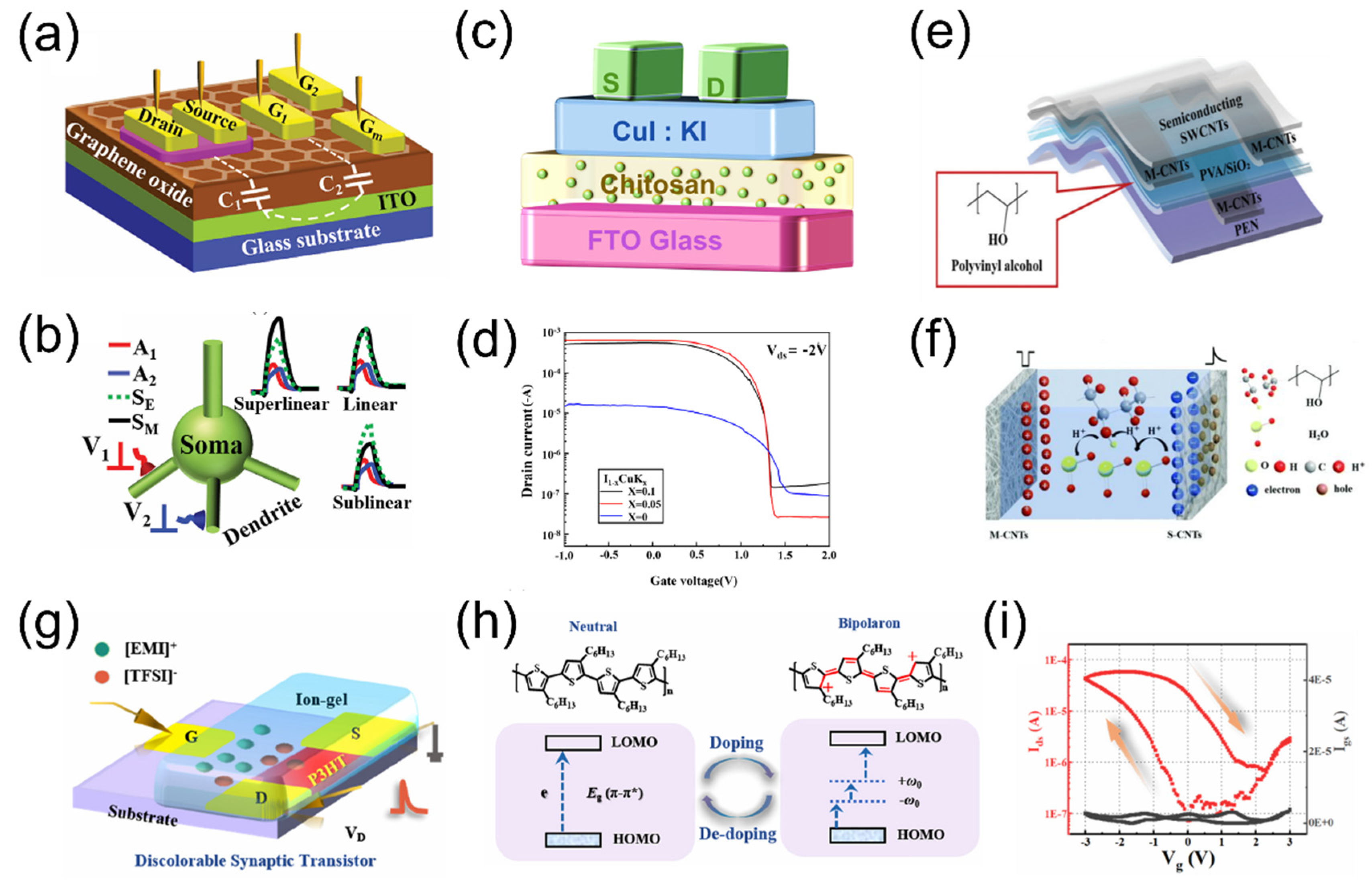
3. Implementation of Neuromorphic Functions on EGTs
3.1. Synaptic Functions

3.2. Neural Functions
3.3. Neuromorphic Computing
4. Bionic Perceptual System Based on EGTs
4.1. Mono-Modal Perception
4.2. Multi-Modal Fusion Perception
5. Summary and Outlook
Funding
Conflicts of Interest
References
- Schuman, C.D.; Kulkarni, S.R.; Parsa, M.; Mitchell, J.P.; Date, P.; Kay, B. Opportunities for neuromorphic computing algorithms and applications. Nat. Comput. Sci. 2022, 2, 10–19. [Google Scholar] [CrossRef]
- Wong, H.S.; Salahuddin, S. Memory leads the way to better computing. Nat. Nanotechnol. 2015, 10, 191–194. [Google Scholar] [CrossRef]
- Zhu, Y.X.; Mao, H.W.; Zhu, Y.; Wang, X.J.; Fu, C.Y.; Ke, S.; Wan, C.J.; Wan, Q. CMOS-compatible neuromorphic devices for neuromorphic perception and computing: A review. Int. J. Extreme Manuf. 2023, 5, 042010. [Google Scholar] [CrossRef]
- Kim, C.H.; Lim, S.; Woo, S.Y.; Kang, W.M.; Seo, Y.T.; Lee, S.T.; Lee, S.; Kwon, D.; Oh, S.; Noh, Y.; et al. Emerging memory technologies for neuromorphic computing. Nanotechnology 2019, 30, 032001. [Google Scholar] [CrossRef]
- Pervez, M.H.; Elahi, E.; Khan, M.A.; Nasim, M.; Asim, M.; Rehmat, A.; Rehman, M.A.; Assiri, M.A.; Rehman, S.; Eom, J.; et al. Recent developments on novel 2D materials for emerging neuromorphic computing devices. Small Struct. 2024, 6, 2400386. [Google Scholar] [CrossRef]
- Yuan, J.R.; Wang, M.; Huang, X.D.; Zhang, T.; Xue, K.H.; Yuan, J.H.; Ou-Yang, J.; Yang, X.F.; Miao, X.S.; Zhu, B.P. Ultrasound: A new strategy for artificial synapses modulation. InfoMat 2024, 6, 12528. [Google Scholar] [CrossRef]
- Xu, H.; Lu, J.K.; Li, Y.; Fang, R.R.; Zhang, W.Y.; Xu, X.X.; Wang, Y.; Liu, Q.; Shang, D.S. Improvement of weight stability in Li-ion-based electrolyte-gated transistor synapse by silica protective process. Appl. Phys. Lett. 2022, 121, 113505. [Google Scholar] [CrossRef]
- Xu, H.; Shang, D.S.; Luo, Q.; An, J.J.; Li, Y.; Wu, S.Y.; Yao, Z.H.; Zhang, W.Y.; Xu, X.X.; Dou, C.M.; et al. A low-power vertical dual-gate neurotransistor with short-term memory for high energy-efficient neuromorphic computing. Nat Commun. 2023, 14, 6385. [Google Scholar] [CrossRef]
- Chen, X.L.; Huang, X.; Li, Y.; Wang, W.S.; Huang, Y.J.; Xiao, H.; Wan, Q.; Zhu, L.Q. Triboelectric potential tuned oxide artificial tactile sensory platform with ultra-low power consumption. Appl. Mater. Today 2024, 36, 102034. [Google Scholar] [CrossRef]
- Guo, L.Q.; Wan, Q.; Wan, C.J.; Zhu, L.Q.; Shi, Y. Short-term memory to Long-term memory transition mimicked in IZO homojunction synaptic transistors. IEEE Electron Device Lett. 2013, 34, 1581–1583. [Google Scholar] [CrossRef]
- Yu, F.; Zhu, L.Q.; Gao, W.T.; Fu, Y.M.; Xiao, H.; Tao, J.; Zhou, J.M. Chitosan-based polysaccharide-gated flexible indium tin oxide synaptic transistor with learning abilities. ACS Appl. Mater. Interfaces. 2018, 10, 16881–16886. [Google Scholar] [CrossRef]
- Huang, Y.J.; Di, J.K.; Li, Y.; Huang, X.; Wang, W.S.; Chen, X.L.; Xiao, H.; Zhu, L.Q. Polyvinyl alcohol electrolyte-gated oxide transistors with tetanization activities for neuromorphic computing. J. Mater. Chem. C 2024, 12, 5166–5174. [Google Scholar] [CrossRef]
- Ren, Z.Y.; Zhu, L.Q.; Guo, Y.B.; Long, T.Y.; Yu, F.; Xiao, H.; Lu, H.L. Threshold-tunable, spike-rate-dependent plasticity originating from interfacial proton gating for pattern learning and memory. ACS Appl Mater. Interfaces 2020, 12, 7833–7839. [Google Scholar] [CrossRef] [PubMed]
- Yu, F.; Zhu, L.Q.; Xiao, H.; Gao, W.T.; Guo, Y.B. Restickable oxide neuromorphic transistors with spike-timing-dependent plasticity and pavlovian associative learning activities. Adv. Funct. Mater. 2018, 28, 1804025. [Google Scholar] [CrossRef]
- Li, N.; He, C.L.; Wang, Q.Q.; Tang, J.S.; Zhang, Q.T.; Shen, C.; Tang, J.; Huang, H.Y.; Wang, S.P.; Li, J.W.; et al. Gate-tunable large-scale flexible monolayer MoS2 devices for photodetectors and optoelectronic synapses. Nano Res. 2022, 15, 5418–5424. [Google Scholar] [CrossRef]
- Wang, Y.R.; Liu, D.X.; Zhang, Y.M.; Fan, L.C.; Ren, Q.Q.; Ma, S.H.; Zhang, M. Stretchable temperature-responsive multimodal neuromorphic electronic skin with spontaneous synaptic plasticity recovery. ACS Nano 2022, 16, 8283–8293. [Google Scholar] [CrossRef] [PubMed]
- Liu, L.; Xu, W.L.; Ni, Y.; Xu, Z.P.; Cui, B.B.; Liu, J.Q.; Wei, H.H.; Xu, W.T. Stretchable neuromorphic transistor that combines multisensing and information processing for epidermal gesture recognition. ACS Nano 2022, 16, 2282–2291. [Google Scholar] [CrossRef] [PubMed]
- Liu, X.; Dai, S.L.; Zhao, W.D.; Zhang, J.Y.; Guo, Z.Y.; Wu, Y.; Xu, Y.T.; Sun, T.R.; Li, L.; Guo, P.; et al. All-photolithography fabrication of ion-gated flexible organic transistor array for multimode neuromorphic computing. Adv. Mater. 2024, 36, 2312473. [Google Scholar] [CrossRef]
- Brousmiche, M.; Rouat, J.; Dupont, S. Multimodal Attentive Fusion Network for audio-visual event recognition. Inf. Fusion 2022, 85, 52–59. [Google Scholar] [CrossRef]
- Zschorlich, V.R.; Behrendt, F.; de Lussanet, M.H.E. Multimodal Sensorimotor Integration of Visual and Kinaesthetic Afferents Modulates Motor Circuits in Humans. Brain Sci. 2021, 11, 187. [Google Scholar] [CrossRef] [PubMed]
- Meredith, M.A.; Stein, B.E. Visual, auditory, and somatosensory convergence on cells in superior colliculus results in multisensory integration. J. Neurophysiol. 1986, 56, 640–662. [Google Scholar] [CrossRef]
- Yu, F.; Zhu, L.Q. Ionotronic Neuromorphic Devices for Bionic Neural Network Applications”. Phys. Status Solidi RRL 2019, 13, 1800674. [Google Scholar] [CrossRef]
- Ren, Z.Y.; Kong, Y.H.; Ai, L.; Xiao, H.; Wang, W.S.; Shi, Z.W.; Zhu, L.Q. Proton gated oxide neuromorphic transistors with bionic vision enhancement and information decoding. J. Mater. Chem. C 2024, 10, 7241–7250. [Google Scholar] [CrossRef]
- Chen, G.X.; Yu, X.P.; Gao, C.S.; Dai, Y.; Hao, Y.X.; Yu, R.J.; Chen, H.P.; Guo, T.L. Temperature-controlled multisensory neuromorphic devices for artificial visual dynamic capture enhancement. Nano Res. 2023, 16, 7661–7670. [Google Scholar] [CrossRef]
- Shi, Z.W.; Ren, Z.Y.; Wang, W.S.; Xiao, H.; Zeng, Y.H.; Zhu, L.Q. Bioinspired tactile perception platform with information encryption function. Chin. Phys. B 2022, 31, 098506. [Google Scholar] [CrossRef]
- Wu, M.G.; Zhuang, Q.N.; Yao, K.M.; Li, J.; Zhao, G.Y.; Zhou, J.K.; Li, D.F.; Shi, R.; Xu, G.Q.; Li, Y.C.; et al. Stretchable, skin-conformable neuromorphic system for tactile sensory recognizing and encoding. InfoMat 2024, 5, e12472. [Google Scholar] [CrossRef]
- Li, P.Z.; Zhang, M.Z.; Zhou, Q.L.; Zhang, Q.H.; Xie, D.G.; Li, G.; Liu, Z.H.; Wang, Z.; Guo, E.J.; He, M.; et al. Reconfigurable optoelectronic transistors for multimodal recognition. Nat. Commun. 2024, 15, 3257. [Google Scholar] [CrossRef]
- Brattain, W.H.; Garrett, C.G.B. Experiments on the interface between germanium and an electrolyte. Bell Syst. Tech. J. 2014, 34, 129–176. [Google Scholar] [CrossRef]
- Zhu, L.Q.; Chao, J.Y.; Xiao, H.; Liu, R.; Wan, Q. Chitosan-based electrolyte gated low voltage oxide transistor with a coplanar modulatory terminal. IEEE Electron Device Lett. 2017, 38, 322–325. [Google Scholar] [CrossRef]
- Fu, Y.M.; Zhu, L.Q.; Wen, J.; Xiao, H.; Liu, R. Mixed protonic and electronic conductors hybrid oxide synaptic transistors. J. Appl. Phys. 2017, 121, 205301. [Google Scholar] [CrossRef]
- Kim, S.H.; Hong, K.; Xie, W.; Lee, K.H.; Zhang, S.P.; Lodge, T.P.; Frisbie, C.D. Electrolyte-gated transistors for organic and printed electronics. Adv. Mater. 2013, 25, 1822–1846. [Google Scholar] [CrossRef] [PubMed]
- Li, J.; Fu, W.H.; Li, L.K.; Jiang, D.L.; He, L.C.; Zhu, W.Q.; Zhang, J.H. Recent advances in solid electrolytes for synaptic transistors. Org. Electron. 2022, 95, 106196. [Google Scholar] [CrossRef]
- Wan, C.J.; Zhu, L.Q.; Liu, Y.H.; Shi, Y.; Wan, Q. Laterally coupled synaptic transistors gated by proton conducting sodium alginate films. IEEE Electron Device Lett. 2014, 35, 672–674. [Google Scholar] [CrossRef]
- Sharbati, M.T.; Du, Y.H.; Torres, J.; Ardolino, N.D.; Yun, M.H.; Xiong, F. Low-power, electrochemically tunable graphene synapses for neuromorphic computing. Adv. Mater. 2018, 30, 1802353. [Google Scholar] [CrossRef]
- Okaue, D.; Tanabe, I.; Ono, S.; Sakamoto, K.; Sato, T.; Imanishi, A.; Morikawa, Y.; Takeya, J.; Fukui, K. Ionic-liquid-originated carrier trapping dynamics at the interface in electric double-layer organic fet revealed by operando interfacial analyses. J. Phys. Chem. C 2020, 124, 2543–2552. [Google Scholar] [CrossRef]
- Wang, D.P.; Zhao, S.F.; Yin, R.Y.; Li, L.L.; Lou, Z.; Shen, G.Z. Recent advanced applications of ion-gel in ionic-gated transistor. npj Flex. Electron. 2021, 5, 13. [Google Scholar] [CrossRef]
- Liu, N.; Zhu, L.Q.; Feng, P.; Wan, C.J.; Liu, Y.H.; Shi, Y.; Wan, Q. Flexible sensory platform based on oxide-based neuromorphic transistors. Sci. Rep. 2015, 5, 18082. [Google Scholar] [CrossRef] [PubMed]
- Jiang, J.; Hu, W.N.; Xie, D.D.; Yang, J.L.; He, J.; Gao, Y.L.; Wan, Q. 2D electric-double-layer phototransistor for photoelectronic and spatiotemporal hybrid neuromorphic integration. Nanoscale 2019, 11, 1360–1369. [Google Scholar] [CrossRef] [PubMed]
- Panzer, M.J.; Frisbie, C.D. Polymer electrolyte gate dielectric reveals finite windows of high conductivity in organic thin film transistors at high charge carrier densities. J. Am. Chem. Soc. 2005, 127, 6960–6961. [Google Scholar] [CrossRef] [PubMed]
- Zou, C.; Sun, J.; Gou, G.Y.; Kong, L.A.; Qian, C.; Dai, G.Z.; Yang, J.L.; Guo, G.H. Polymer-electrolyte-gated nanowire synaptic transistors for neuromorphic applications. Appl. Phys. A 2017, 123, 597. [Google Scholar] [CrossRef]
- Wang, Y.R.; Yang, Y.F.; He, Z.Y.; Zhu, H.; Chen, L.; Sun, Q.Q.; Zhang, D.W. Laterally coupled 2D MoS2 synaptic transistor with ion gating. IEEE Electron Device Lett. 2020, 41, 1424–1427. [Google Scholar] [CrossRef]
- Lee, H.; Cho, J.; Jin, M.; Lee, J.H.; Lee, C.; Kim, J.; Lee, J.; Shin, J.C.; Yoo, J.; Lee, E.; et al. Electrochemical analysis of ion effects on electrolyte-gated synaptic transistor characteristics. ACS Nano 2024, 18, 5383–5395. [Google Scholar] [CrossRef] [PubMed]
- Kim, D.; Liu, X.; Yu, B.Z.; Mateti, S.; O’Dell, L.A.; Rong, Q.Z.; Chen, Y. Amine-functionalized boron nitride nanosheets: A new functional additive for robust, flexible ion gel electrolyte with high lithium-ion transference number. Adv. Funct. Mater. 2020, 30, 1910813. [Google Scholar] [CrossRef]
- Yuan, H.T.; Shimotani, H.; Tsukazaki, A.; Ohtomo, A.; Kawasaki, M.; Iwasa, Y. High-density carrier accumulation in ZnO field-effect transistors gated by electric double layers of ionic liquids. Adv. Funct. Mater. 2009, 19, 1046–1053. [Google Scholar] [CrossRef]
- Molina-Lopez, F.; Gao, T.Z.; Kraft, U.; Zhu, C.; Öhlund, T.; Pfattner, R.; Feig, V.R.; Kim, Y.; Wang, S.; Yun, Y.; et al. Inkjet-printed stretchable and low voltage synaptic transistor array. Nat. Commun. 2019, 10, 2676. [Google Scholar] [CrossRef]
- Chen, L.Y.; Fu, J.F.; Lu, Q.; Shi, L.Y.; Li, M.M.; Dong, L.N.; Xu, Y.F.; Jia, R.R. Cross-linked polymeric ionic liquids ion gel electrolytes by in situ radical polymerization. Chem. Eng. J. 2019, 378, 122245. [Google Scholar] [CrossRef]
- Chouhdry, H.H.; Lee, D.H.; Bag, A.; Lee, N.E. A flexible artificial chemosensory neuronal synapse based on chemoreceptive ionogel-gated electrochemical transistor. Nat. Commun. 2023, 14, 821. [Google Scholar] [CrossRef] [PubMed]
- Zhou, J.M.; Wan, C.J.; Zhu, L.Q.; Shi, Y.; Wan, Q. Synaptic behaviors mimicked in flexible oxide-based transistors on plastic substrates. IEEE Electron Device Lett. 2013, 34, 1433–1435. [Google Scholar] [CrossRef]
- Zhu, L.Q.; Xiao, H.; Liu, Y.H.; Wan, C.J.; Shi, Y.; Wan, Q. Multi-gate synergic modulation in laterally coupled synaptic transistors. Appl. Phys. Lett. 2015, 107, 143502. [Google Scholar] [CrossRef]
- Wang, W.S.; Ren, Z.Y.; Shi, Z.W.; Xiao, H.; Zeng, Y.H.; Zhu, L.Q. Flexible Nanocellulose Gated Pseudo-Diode for Neuromorphic Electronic Applications. IEEE Electron Device Lett. 2022, 43, 737–740. [Google Scholar] [CrossRef]
- Jiang, J.; Wan, Q.; Sun, J.; Lu, A.X. Ultralow-voltage transparent electric-double-layer thin-film transistors processed at room-temperature. Appl. Phys. Lett. 2009, 95, 152114. [Google Scholar] [CrossRef]
- Zhu, L.Q.; Wan, C.J.; Guo, L.Q.; Shi, Y.; Wan, Q. Artificial synapse network on inorganic proton conductor for neuromorphic systems. Nat. Commun. 2014, 5, 3158. [Google Scholar] [CrossRef] [PubMed]
- Liu, Y.H.; Wan, X.; Zhu, L.Q.; Shi, Y.; Wan, Q. Laterally coupled dual-gate oxide-based transistors on sodium alginate electrolytes. IEEE Electron Device Lett. 2014, 35, 1257–1259. [Google Scholar] [CrossRef]
- Yuan, H.T.; Shimotani, H.; Ye, J.T.; Yoon, S.; Aliah, H.; Tsukazaki, A.; Kawasaki, M.; Iwasa, Y. Electrostatic and Electrochemical Nature of Liquid-Gated Electric-Double-Layer Transistors Based on Oxide Semiconductors. J. Am. Chem. Soc. 2010, 132, 18402–18407. [Google Scholar] [CrossRef]
- Zhu, L.Q.; Xiao, H.; Wang, J.X. Lateral-coupled oxide electric-double-layer transistors gated by scandia-ceria-stabilized zirconia electrolyte. J. Phys. D Appl. Phys. 2016, 49, 025104. [Google Scholar] [CrossRef]
- Yu, C.L.; Li, S.R.; Pan, Z.J.; Liu, Y.M.; Wang, Y.C.; Zhou, S.Y.; Gao, Z.T.; Tian, H.; Jiang, K.L.; Wang, Y.Y.; et al. Gate-controlled neuromorphic functional transition in an electrochemical graphene transistor. Nano Lett. 2024, 24, 1620–1628. [Google Scholar] [CrossRef] [PubMed]
- Wang, X.M.; Yan, Y.J.; Li, E.L.; Liu, Y.Q.; Lai, D.X.; Lin, Z.X.; Liu, Y.; Chen, H.P.; Guo, T.L. Stretchable synaptic transistors with tunable synaptic behavior. Nano Energy 2020, 75, 104952. [Google Scholar] [CrossRef]
- Liu, N.; Liu, Y.H.; Feng, P.; Zhu, L.Q.; Shi, Y.; Wan, Q. Enhancing the pH sensitivity by laterally synergic modulation in dual-gate electric-double-layer transistors. Appl. Phys. Lett. 2015, 106, 073507. [Google Scholar] [CrossRef]
- Liu, R.; Zhu, L.Q.; Wang, W.; Xiao, H.; Liu, Z.P.; Wan, Q. Biodegradable Oxide Synaptic transistors gated by a biopolymer electrolyte. J. Mater. Chem. C 2016, 4, 7744–7750. [Google Scholar] [CrossRef]
- Yang, Y.; Cui, H.Y.; Ke, S.; Pei, M.J.; Shi, K.L.; Wan, C.J.; Wan, Q. Reservoir computing based on electric-double-layer coupled InGaZnO artificial synapse. Appl. Phys. Lett. 2023, 122, 043508. [Google Scholar] [CrossRef]
- Gu, L.J.; Li, Y.R.; Xie, D.D.; Jiang, J. Fully Optical-Driving Ionotronic InGaZnO4 Phototransistor for Gate-Tunable Bidirectional Photofiltering and Visual Perception. IEEE Trans. Electron. Device 2022, 69, 4382–4385. [Google Scholar] [CrossRef]
- Huang, Y.L.; Qiu, W.; Liu, W.R.; Jin, C.X.; Sun, J.; Yang, J.L. Non-Volatile In-Ga-Zn-O Transistors for Neuromorphic Computing. Appl. Phys. A-Mater. Sci. Proc. 2021, 127, 356. [Google Scholar] [CrossRef]
- Li, Y.R.; Song, H.L.; Jiang, J. Vertical Ion-Coupling Ga2O3 TFT With Spatiotemporal Logic Encryption. IEEE Trans. Electron. Device 2023, 70, 3122–3125. [Google Scholar] [CrossRef]
- Li, Y.; Huang, Y.J.; Chen, X.L.; Wang, W.S.; Huang, X.; Xiao, H.; Zhu, L.Q. Multi-terminal pectin/chitosan hybrid electrolyte gated oxide neuromorphic transistor with multi-mode cognitive activities. Front. Phys. 2024, 19, 53204. [Google Scholar] [CrossRef]
- Wan, C.J.; Chen, G.; Fu, Y.M.; Wang, M.; Matsuhisa, N.; Pan, S.W.; Pan, L.; Yang, H.; Wan, Q.; Zhu, L.Q.; et al. An artificial sensory neuron with tactile perceptual learning. Adv. Mater. 2018, 30, 1801291. [Google Scholar] [CrossRef] [PubMed]
- Wan, C.J.; Zhu, L.Q.; Liu, Y.H.; Feng, P.; Liu, Z.P.; Cao, H.L.; Xiao, P.; Shi, Y.; Wan, Q. Proton-conducting graphene oxide-coupled neuron transistors for brain-Inspired cognitive systems. Adv. Mater. 2016, 28, 3557–3563. [Google Scholar] [CrossRef] [PubMed]
- Lei, J.Y.; Dou, W.; Hou, W.; Gan, X.M.; Jiang, G.G.; Yin, Y.L.; Yang, J.; Deng, P.F.; Tang, D.S. Synaptic plasticity and memory mimicked in solution-processed K-doped CuI thin film transistors. Appl. Phys. Lett. 2024, 124, 033504. [Google Scholar] [CrossRef]
- Wang, Y.R.; Huang, W.H.; Zhang, Z.W.; Fan, L.C.; Huang, Q.Y.; Wang, J.X.; Zhang, Y.M.; Zhang, M. Ultralow-power flexible transparent carbon nanotube synaptic transistors for emotional memory. Nanoscale 2021, 13, 11360–11369. [Google Scholar] [CrossRef]
- Chang, Y.; Cong, H.F.; Zhou, R.F.; Zhang, W.X.; Qin, Y.B.; Liu, X.H.; Wang, F.Y. Enhanced artificial synaptic properties enabled by arrays of electrolyte-gated electrospun InZnO nanowires. ACS Appl. Electron. Mater. 2022, 4, 2570–2579. [Google Scholar] [CrossRef]
- Gou, G.Y.; Sun, J.; Qian, C.; He, Y.K.; Kong, L.A.; Fu, Y.; Dai, G.Z.; Yang, J.L.; Gao, Y.L. Artificial synapses based on biopolymer electrolyte-coupled SnO2 nanowire transistors. J. Mater. Chem. C 2017, 4, 11110–11117. [Google Scholar] [CrossRef]
- Zhu, Y.X.; Peng, B.C.; Zhu, L.; Chen, C.S.; Wang, X.J.; Mao, H.W.; Zhu, Y.; Fu, C.Y.; Ke, S.; Wan, C.J.; et al. IGZO nanofiber photoelectric neuromorphic transistors with indium ratio tuned synaptic plasticity. Appl. Phys. Lett. 2022, 121, 133502. [Google Scholar] [CrossRef]
- Tian, H.; Guo, Q.S.; Xie, Y.J.; Zhao, H.; Li, C.; Cha, J.J.; Xia, F.N.; Wang, H. Anisotropic black phosphorus synaptic device for neuromorphic applications. Adv. Mater. 2016, 28, 4991–4997. [Google Scholar] [CrossRef]
- Wu, B.M.; Wang, X.D.; Tang, H.W.; Jiang, W.; Chen, Y.; Wang, Z.; Cui, Z.Z.; Lin, T.; Shen, H.; Hu, W.D.; et al. Multifunctional MoS2 Transistors with Electrolyte Gel Gating. Small 2020, 16, 2000420. [Google Scholar] [CrossRef] [PubMed]
- Gao, N.; Zhou, R.; Tu, B.; Tao, T.; Song, Y.Q.; Cai, Z.W.; He, H.P.; Chang, G.; Wu, Y.X.; He, Y.B. Graphene electrochemical transistor incorporated with gel electrolyte for wearable and non-invasive glucose monitoring. Anal. Chim. Acta 2022, 1239, 340719. [Google Scholar] [CrossRef] [PubMed]
- Sun, C.; Liu, X.R.; Yao, Q.X.; Jiang, Q.; Xia, X.L.; Shen, Y.F.; Ye, X.Y.; Tan, H.W.; Gao, R.S.; Zhu, X.J.; et al. A discolorable flexible synaptic transistor for wearable health monitoring. ACS Nano 2023, 18, 515–525. [Google Scholar] [CrossRef]
- Caporale, N.; Dan, Y. Spike timing-dependent plasticity: A Hebbian learning rule. Annu. Rev. Neurosci. 2008, 31, 25–46. [Google Scholar] [CrossRef]
- Smith, A.J.; Owens, S.; Forsythe, I.D. Characterisation of inhibitory and excitatory postsynaptic currents of the rat medial superior olive. J. Physiol. 2000, 529, 681–698. [Google Scholar] [CrossRef]
- Gong, B.C.; Wang, W.S.; Zhou, S.Y.; Di, J.K.; Huang, X.; Huang, Y.J.; Xiao, H.; Zhu, L.Q. Ionotronic Oxide Neuromorphic Transistor with Pair-, Triplet- and Quadruplet-Spike-Timing-Dependent Plasticity Activities. Appl. Phys. Lett. 2024, 125, 263502. [Google Scholar] [CrossRef]
- Xu, X.D.; Dou, W.; Chen, P.F.; Peng, Y.L.; Ai, Y.J.; Jiang, G.G.; Deng, P.F.; Yin, Y.L.; Peng, Y.H.; Tang, D.S. Low-voltage solution-processed Sn-doped CuI neuromorphic transistors with synaptic plasticity and pain mimicked. Appl. Phys. Lett. 2024, 125, 053501. [Google Scholar] [CrossRef]
- Chen, X.L.; Gong, B.C.; Li, Y.; Wang, W.S.; Huang, X.; Huang, Y.J.; Xiao, H.; Zhu, L.Q. Proton Competitive Activities in Flexible Hydrogel Gated Oxide Neuromorphic Transistor for Mimicking Bienenstock-Cooper-Munro Learning Rule. IEEE Trans. Electron Devices 2024, 71, 4355–4361. [Google Scholar] [CrossRef]
- Van de Burgt, Y.; Lubberman, E.; Fuller, E.J.; Keene, S.T.; Faria, G.C.; Agarwal, S.; Marinella, M.J.; Talin, A.A.; Salleo, A. A non-volatile organic electrochemical device as a low-voltage artificial synapse for neuromorphic computing. Nat. Mater. 2017, 16, 414–418. [Google Scholar] [CrossRef] [PubMed]
- Abraham, W.C.; Bear, M.F. Metaplasticity: The plasticity of synaptic plasticity. Trends Neurosci. 1996, 19, 126–130. [Google Scholar] [CrossRef]
- Abraham, W.C. Metaplasticity: Tuning synapses and networks for plasticity. Nat. Rev. Neurosci. 2008, 9, 387–399. [Google Scholar] [CrossRef]
- John, R.A.; Liu, F.C.; Chien, N.A.; Kulkarni, M.R.; Zhu, C.; Fu, Q.D.; Basu, A.; Liu, Z.; Mathews, N. Synergistic gating of electro-iono-photoactive 2D chalcogenide neuristors: Coexistence of hebbian and homeostatic synaptic metaplasticity. Adv. Mater. 2018, 30, 1800220. [Google Scholar] [CrossRef]
- Shi, Z.W.; Wang, W.S.; Ai, L.; Li, Y.; Li Chen, X.; Xiao, H.; Zeng, Y.H.; Zhu, L.Q. Non-associative learning behavior in mixed proton and electron conductor hybrid pseudo-diode. J. Mater. Sci. Technol. 2023, 160, 204–213. [Google Scholar] [CrossRef]
- Harikesh, P.C.; Yang, C.Y.; Tu, D.Y.; Gerasimov, J.Y.; Dar, A.M.; Armada-Moreira, A.; Massetti, M.; Kroon, R.; Bliman, D.; Olsson, R.; et al. Organic electrochemical neurons and synapses with ion mediated spiking. Nat. Commun. 2022, 13, 901. [Google Scholar] [CrossRef]
- Sidiropoulou, K.; Pissadaki, E.K.; Poirazi, P. Inside the brain of a neuron. EMBO Rep. 2006, 7, 886–892. [Google Scholar] [CrossRef] [PubMed]
- Izhikevich, E.M. Which model to use for cortical spiking neurons? IEEE Trans Neural Netw. IEEE Trans Neural Netw. 2004, 15, 1063–1070. [Google Scholar] [CrossRef]
- Hodgkin, A.L.; Huxley, A.F. The components of membrane conductance in the giant axon of loligo. J. Physiol. 1952, 116, 473–496. [Google Scholar] [CrossRef] [PubMed]
- Yi, W.; Tsang, K.K.; Lam, S.K.; Bai, X.W.; Crowell, J.A.; Flores, E.A. Biological plausibility and stochasticity in scalable VO2 active memristor neurons. Nat. Commun. 2018, 9, 4661. [Google Scholar] [CrossRef]
- Cao, R.R.; Zhang, X.M.; Liu, S.; Lu, J.K.; Wang, Y.Z.; Jiang, H.; Yang, Y.; Sun, Y.Z.; Wei, W.; Wang, J.L.; et al. Compact artificial neuron based on anti-ferroelectric transistor. Nat. Commun. 2022, 13, 7018. [Google Scholar] [CrossRef] [PubMed]
- Teeter, C.; Iyer, R.; Menon, V.; Gouwens, N.; Feng, D.; Berg, J.; Szafer, A.; Cain, N.; Zeng, H.K.; Hawrylycz, M.; et al. Generalized leaky integrate-and-fire models classify multiple neuron types. Nat. Commun. 2018, 9, 709. [Google Scholar] [CrossRef]
- Hua, Q.L.; Wu, H.Q.; Gao, B.; Zhang, Q.T.; Wu, W.; Li, Y.J.O.; Wang, X.H.; Hu, W.G.; Qian, H. Low-voltage oscillatory neurons for memristor-based neuromorphic systems. Glob. Chall. 2019, 3, 1900015. [Google Scholar] [CrossRef] [PubMed]
- Gao, L.G.; Chen, P.Y.; Yu, S.M. NbOx based oscillation neuron for neuromorphic computing. Appl. Phys. Lett. 2017, 111, 103503. [Google Scholar] [CrossRef]
- Baek, E.; Song, S.; Baek, C.K.; Rong, Z.; Shi, L.P.; Cannistraci, C.V. Neuromorphic dendritic network computation with silent synapses for visual motion perception. Nat. Electron. 2024, 7, 454–465. [Google Scholar] [CrossRef]
- Harikesh, P.C.; Yang, C.Y.; Wu, H.Y.; Zhang, S.L.; Donahue, M.J.; Caravaca, A.S.; Huang, J.D.; Olofsson, P.S.; Berggren, M.; Tu, D.; et al. Ion-tunable antiambipolarity in mixed ion-electron conducting polymers enables biorealistic organic electrochemical neurons. Nat. Mater. 2023, 22, 242–248. [Google Scholar] [CrossRef] [PubMed]
- Di, J.K.; Huang, Y.J.; Wang, W.S.; Huang, X.; Xiao, H.; Zhu, L.Q. Oxide-based bionic hetero-dendritic neuron with capabilities of Bienenstock-Cooper-Munro learning activities. J. Mater. Chem. C 2025, 13, 1658–1667. [Google Scholar] [CrossRef]
- He, Y.L.; Nie, S.; Liu, R.; Jiang, S.S.; Shi, Y.; Wan, Q. Spatiotemporal information processing emulated by multiterminal neuro-transistor networks. Adv. Mater. 2019, 31, 1900903. [Google Scholar] [CrossRef] [PubMed]
- Mead, C. Neuromorphic electronic systems. Proc. IEEE. 1990, 78, 1629–1636. [Google Scholar] [CrossRef]
- Yuan, R.; Tiw, P.J.; Cai, L.; Yang, Z.Y.; Liu, C.; Zhang, T.; Ge, C.; Huang, R.; Yang, Y.C. A neuromorphic physiological signal processing system based on VO2 memristor for next-generation human-machine interface. Nat. Commun. 2023, 14, 3695. [Google Scholar] [CrossRef] [PubMed]
- Sadaf, M.U.; Sakib, N.U.; Pannone, A.; Ravichandran, H.; Das, S. A bio-inspired visuotactile neuron for multisensory integration. Nat. Commun. 2023, 14, 5729. [Google Scholar] [CrossRef] [PubMed]
- Shim, H.; Sim, K.; Ershad, F.; Yang, P.Y.; Thukral, A.; Rao, Z.; Kim, H.J.; Liu, Y.H.; Wang, X.; Gu, G.Y.; et al. Stretchable elastic synaptic transistors for neurologically integrated soft engineering systems. Sci. Adv. 2019, 5, eaax4961. [Google Scholar] [CrossRef] [PubMed]
- Jin, M.; Lee, H.; Im, C.; Na, H.J.; Lee, J.H.; Lee, W.H.; Han, J.; Lee, E.; Park, J.; Kim, Y.S. Interfacial ion-trapping electrolyte-gated transistors for high-fidelity neuromorphic computing. Adv. Funct. Mater. 2022, 32, 2201048. [Google Scholar] [CrossRef]
- Wang, W.S.; Shi, Z.W.; Chen, X.L.; Li, Y.; Xiao, H.; Zeng, Y.H.; Pi, X.D.; Zhu, L.Q. Biodegradable oxide neuromorphic transistors for neuromorphic computing and anxiety disorder emulation. ACS Appl. Mater. Interfaces. 2023, 15, 47640–47648. [Google Scholar] [CrossRef] [PubMed]
- Schroeder, C.E. Multisensory contributions to low-level, ’unisensory’ processing. Curr. Opin. Neurobiol. 2005, 15, 454–458. [Google Scholar] [CrossRef] [PubMed]
- Lakatos, P.; Chen, C.M.; O’Connell, M.N.; Mills, A.; Schroeder, C.E. Neuronal oscillations and multisensory interaction in primary auditory cortex. Neuron 2007, 53, 279–292. [Google Scholar] [CrossRef]
- Stein, B.E.; Stanford, T.R. Multisensory integration: Current issues from the perspective of the single neuron. Nat. Rev. Neurosci. 2008, 9, 406. [Google Scholar] [CrossRef]
- Tan, D.C.; Zhang, Z.R.; Shi, H.H.; Sun, N.; Li, Q.K.; Bi, S.; Huang, J.J.; Liu, Y.H.; Guo, Q.L.; Jiang, C.M. Bioinspired artificial visual-respiratory synapse as multimodal scene recognition system with oxidized-vacancies mxene. Adv. Mater. 2024, 36, 2407751. [Google Scholar] [CrossRef]
- Zhou, S.Y.; Huang, X.; Wang, W.S.; Gong, B.C.; Di, J.K.; Huang, Y.J.; Zhu, L.Q. Cognitive Tactile Perceptual System by Integrating Oxide Neuromorphic Transistor with Triboelectric Nanogenerator. IEEE Trans. Electron Device 2025, 72, 845–851. [Google Scholar] [CrossRef]
- Huang, Y.J.; Di, J.K.; Wang, W.S.; Huang, X.; Zhou, S.Y.; Gong, B.C.; Zhao, Z.Q.; Zhu, L.Q. Artificial Tactile Perceptual System Based on Capacitive Tactile Sensor and Oxide Neuromorphic Transistor. Appl. Mater. Today 2024, 41, 102521. [Google Scholar] [CrossRef]
- Li, G.; Xie, D.G.; Zhong, H.; Zhang, Z.Y.; Fu, X.K.; Zhou, Q.L.; Li, Q.; Ni, H.; Wang, J.O.; Guo, E.J.; et al. Photo-induced non-volatile VO2 phase transition for neuromorphic ultraviolet sensors. Nat. Commun. 2022, 13, 1729. [Google Scholar] [CrossRef] [PubMed]
- Han, M.J.; Tsukruk, V.V. Trainable bilingual synaptic functions in bio-enabled synaptic transistors. ACS Nano 2023, 17, 18883–18892. [Google Scholar] [CrossRef] [PubMed]
- Jiang, C.M.; Tan, D.C.; Sun, N.; Huang, J.J.; Ji, R.N.; Li, Q.K.; Bi, S.; Guo, Q.L.; Wang, X.H.; Song, J.H. 60 nm Pixel-size pressure piezo-memory system as ultrahigh-resolution neuromorphic tactile sensor for in-chip computing. Nano Energy 2021, 87, 106190. [Google Scholar] [CrossRef]
- Jiang, C.M.; Li, Q.K.; Sun, N.; Huang, J.J.; Ji, R.N.; Bi, S.; Guo, Q.L.; Song, J.H. A high-performance bionic pressure memory device based on piezo-OLED and piezo-memristor as luminescence-fish neuromorphic tactile system. Nano Energy 2020, 77, 105120. [Google Scholar] [CrossRef]
- Wang, W.; Jiang, Y.; Zhong, D.; Zhang, Z.; Choudhury, S.; Lai, J.C.; Gong, H.; Niu, S.; Yan, X.; Zheng, Y.; et al. Neuromorphic sensorimotor loop embodied by monolithically integrated, low-voltage, soft e-skin. Science 2023, 380, 735–742. [Google Scholar] [CrossRef]
- Dai, S.L.; Dai, Y.H.; Zhao, Z.X.; Xia, F.F.; Li, Y.; Liu, Y.D.; Cheng, P.; Strzalka, J.; Li, S.S.; Li, N.; et al. Intrinsically stretchable neuromorphic devices for on-body processing of health data with artificial intelligence. Matter 2022, 5, 3375–3390. [Google Scholar] [CrossRef]
- Ohshiro, T.; Angelaki, D.E.; DeAngelis, G.C. A normalization model of multisensory integration. Nat. Neurosci. 2011, 14, 775–782. [Google Scholar] [CrossRef]
- Wang, W.S.; Chen, X.L.; Huang, Y.J.; Huang, X.; Zhu, L.Q. Bionic visual-auditory perceptual system based on ionotronic neuromorphic transistor for information encryption and decryption with sound recognition functions. Adv. Electron. Mater. 2024, 2400642. [Google Scholar] [CrossRef]
- Angelaki, D.E.; Gu, Y.; DeAngelis, G.C. Multisensory integration: Psychophysics, neurophysiology, and computation. Curr. Opin. Neurobiol. 2009, 19, 452–458. [Google Scholar] [CrossRef]
- Wan, C.J.; Cai, P.Q.; Guo, X.T.; Wang, M.; Matsuhisa, N.; Yang, L.; Lv, Z.S.; Luo, Y.F.; Loh, X.J.; Chen, X.D. An artificial sensory neuron with visual-haptic fusion. Nat. Commun. 2020, 11, 4602. [Google Scholar] [CrossRef]
- Wang, W.S.; Zhu, L.Q. Recent advances in neuromorphic transistors for artificial perception applications. Sci. Technol. Adv. Mater. 2023, 24, 10–41. [Google Scholar] [CrossRef] [PubMed]
- Liu, X.R.; Sun, C.; Ye, X.Y.; Zhu, X.J.; Hu, C.; Tan, H.W.; He, S.; Shao, M.J.; Li, R.W. Neuromorphic nanoionics for human-machine interaction: From materials to applications. Adv. Mater. 2024, 36, 2311472. [Google Scholar] [CrossRef] [PubMed]
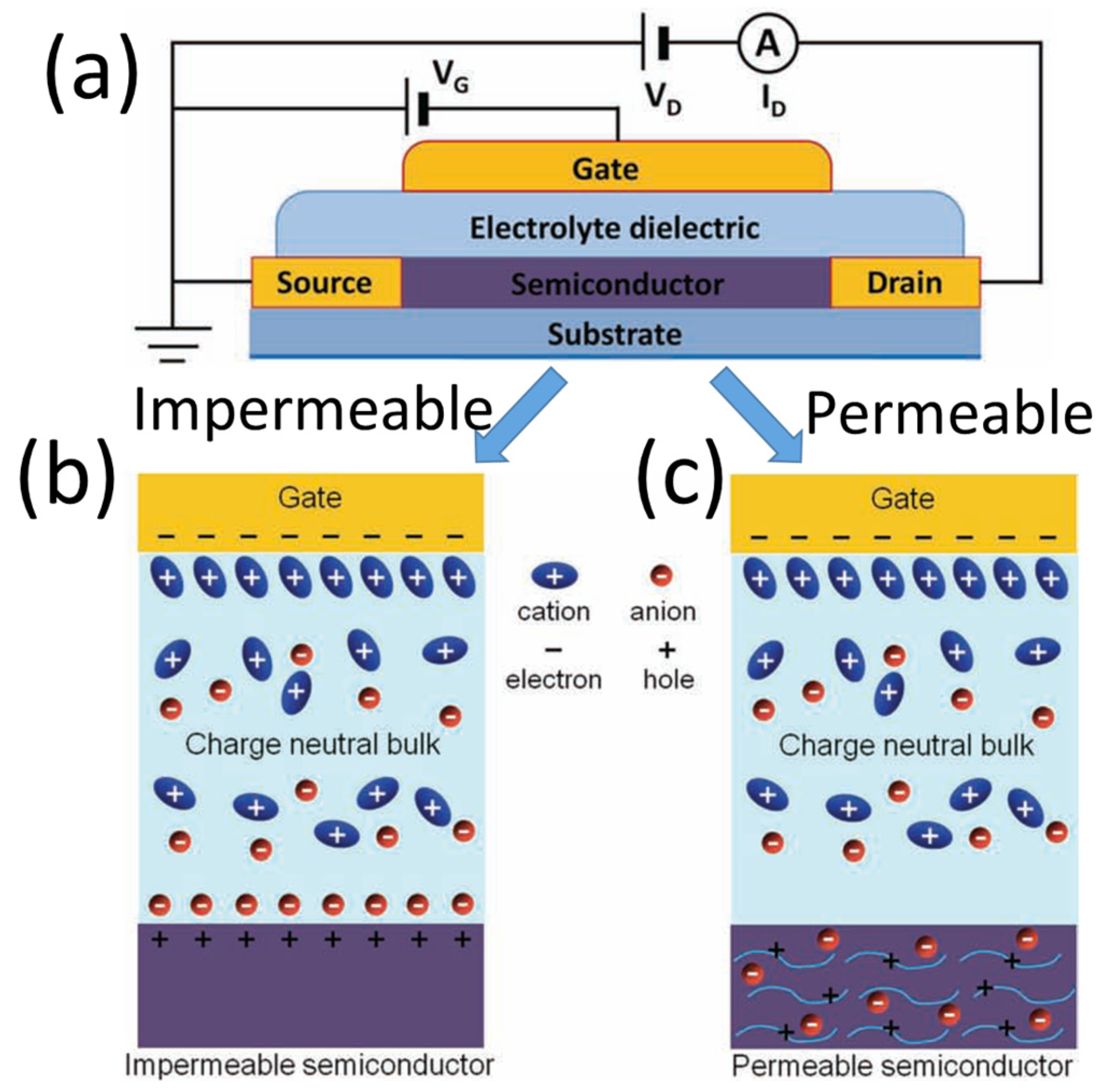
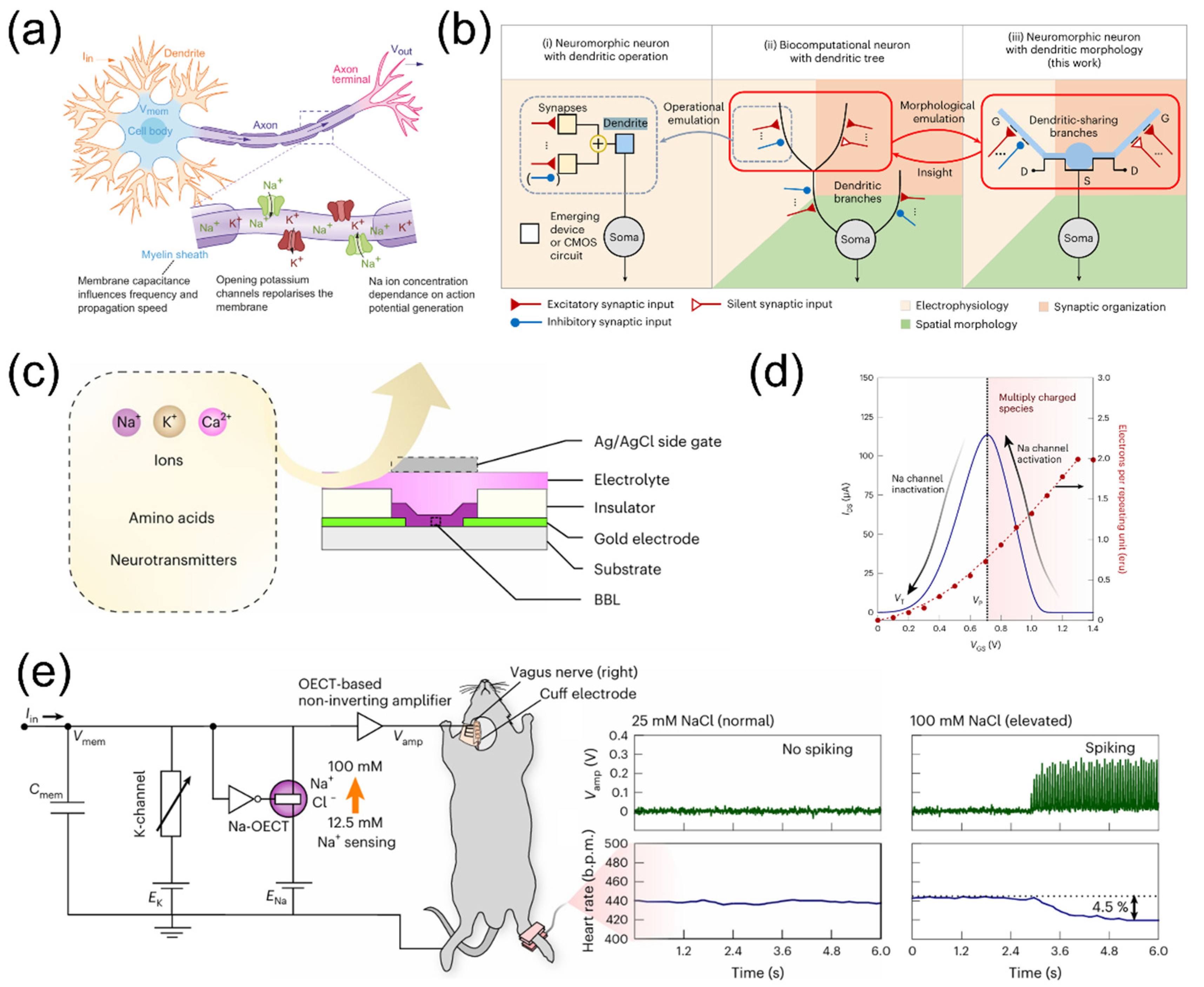

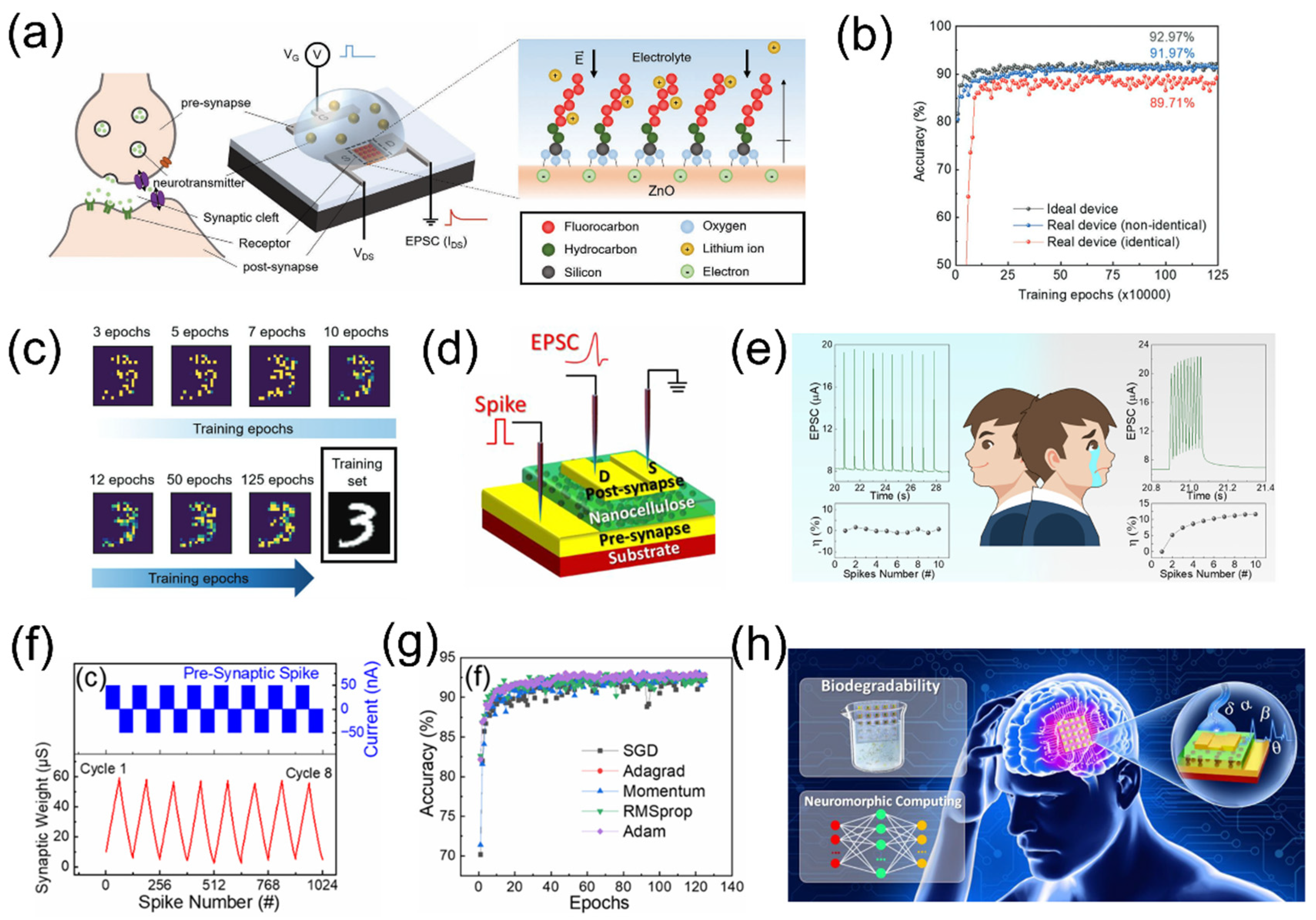
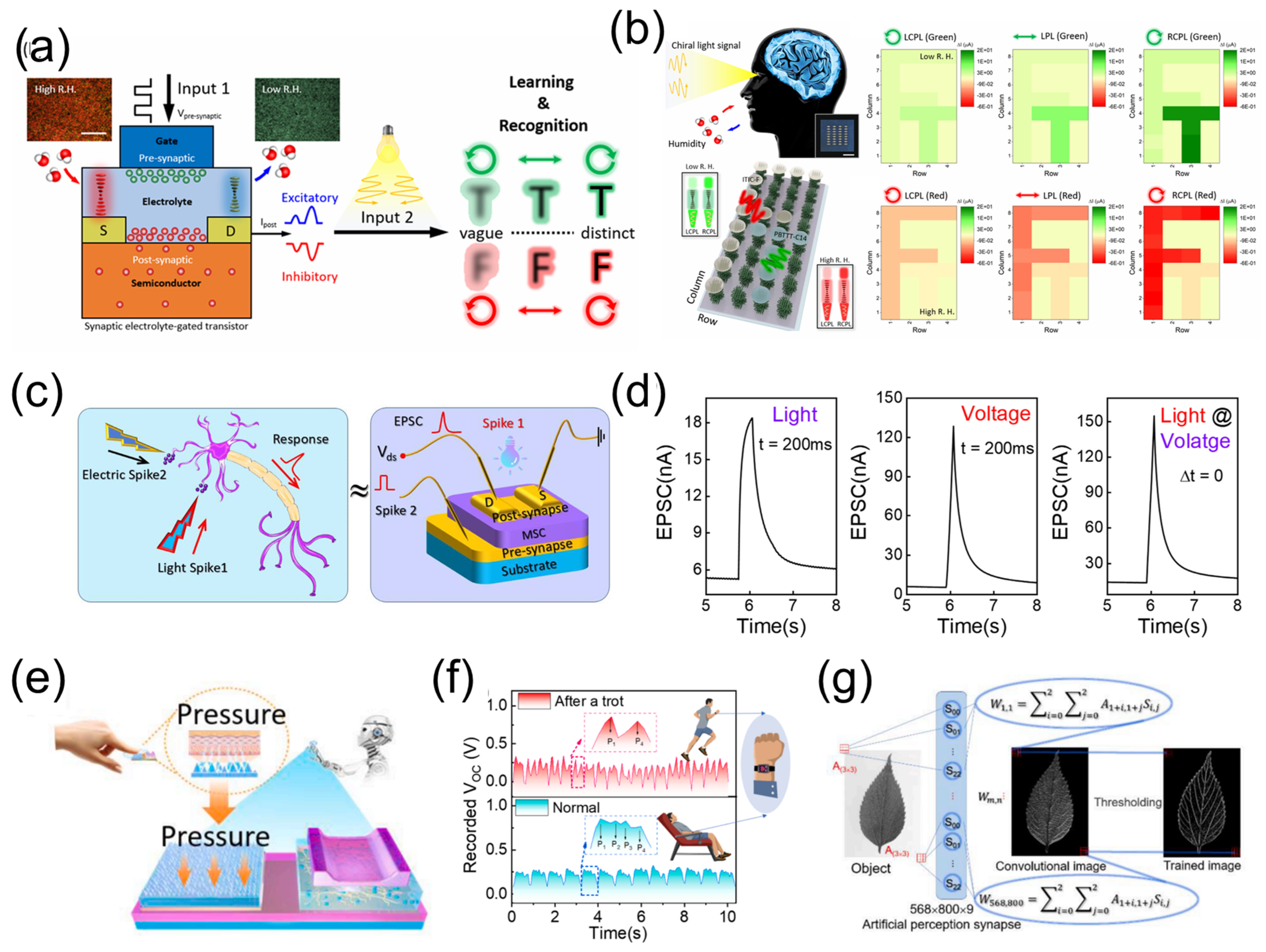
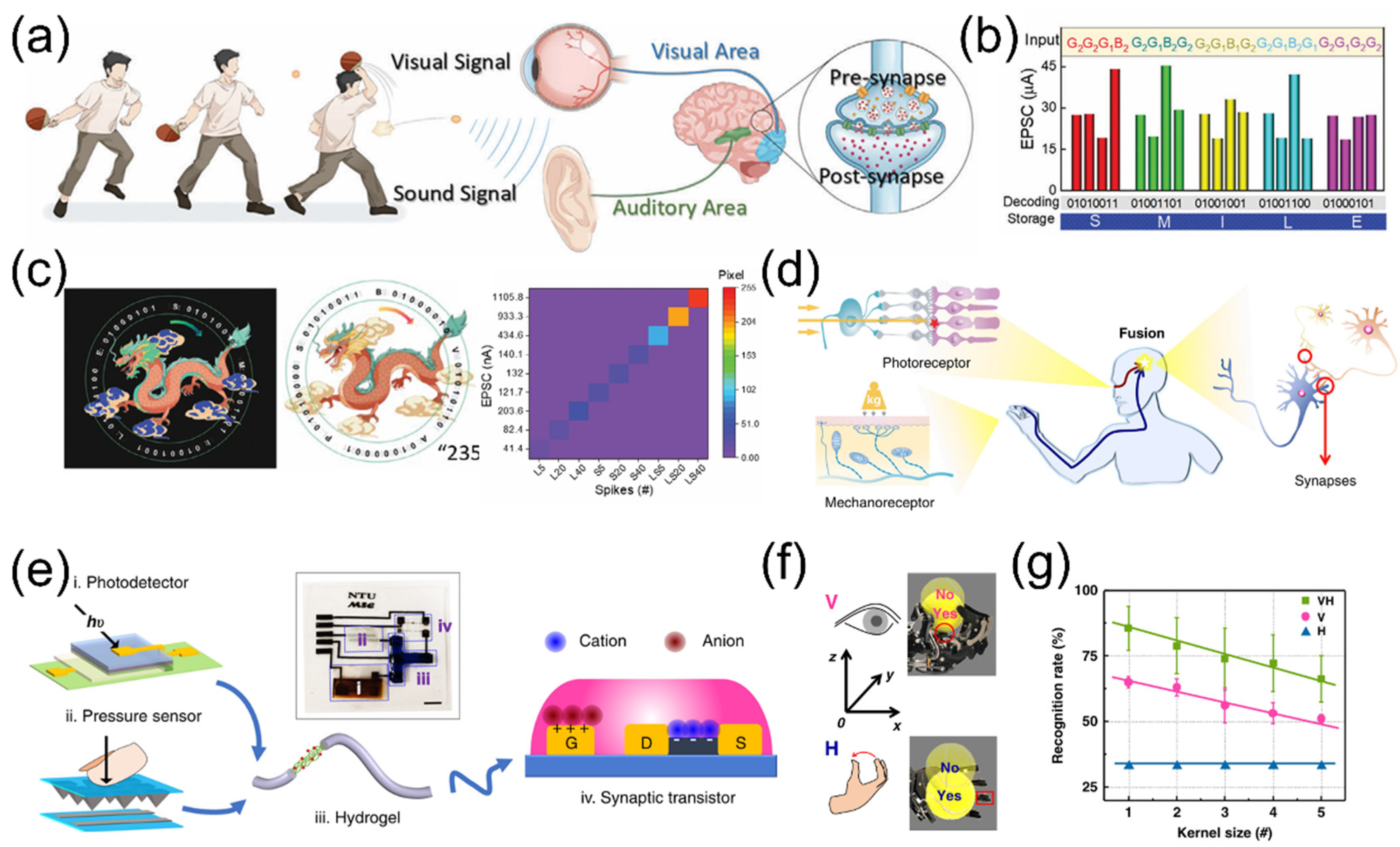
Disclaimer/Publisher’s Note: The statements, opinions and data contained in all publications are solely those of the individual author(s) and contributor(s) and not of MDPI and/or the editor(s). MDPI and/or the editor(s) disclaim responsibility for any injury to people or property resulting from any ideas, methods, instructions or products referred to in the content. |
© 2025 by the authors. Licensee MDPI, Basel, Switzerland. This article is an open access article distributed under the terms and conditions of the Creative Commons Attribution (CC BY) license (https://creativecommons.org/licenses/by/4.0/).
Share and Cite
Wang, W.; Zhu, L. Electrolyte Gated Transistors for Brain Inspired Neuromorphic Computing and Perception Applications: A Review. Nanomaterials 2025, 15, 348. https://doi.org/10.3390/nano15050348
Wang W, Zhu L. Electrolyte Gated Transistors for Brain Inspired Neuromorphic Computing and Perception Applications: A Review. Nanomaterials. 2025; 15(5):348. https://doi.org/10.3390/nano15050348
Chicago/Turabian StyleWang, Weisheng, and Liqiang Zhu. 2025. "Electrolyte Gated Transistors for Brain Inspired Neuromorphic Computing and Perception Applications: A Review" Nanomaterials 15, no. 5: 348. https://doi.org/10.3390/nano15050348
APA StyleWang, W., & Zhu, L. (2025). Electrolyte Gated Transistors for Brain Inspired Neuromorphic Computing and Perception Applications: A Review. Nanomaterials, 15(5), 348. https://doi.org/10.3390/nano15050348






